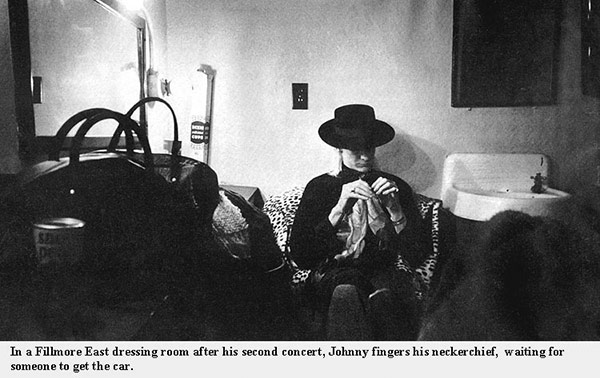Music Epitome of Blackness
His white cornsilk hair hangs down to his shoulders and frames the creamy white skin and pointed nose on his face. His eyebrows and lashes are also white and they accent his pale, crossed eyes. This is Johnny Winter. As an albino, he is physically pure white: as a musician, he is the epitome of blackness. Winter is a guitarist and a vocalist, one of the unusual ones who somehow built up a respectable reputation as a blues man before he ever stepped 'into a recording studio. Born in Beaumont, Texas, 25 years ago, he was a child when his family moved to Mississippi to operate a cotton plantation. It was there that the blues first took hold on him.
The family eventually moved back to Texas, where Winter learned to play ukulele and guitar. With his kid brother Edgar (also white-haired), Winter started a teen-age blues group and made the rounds of the small road-side clubs in the South. After a semester at La-Mar Technical College, he left Texas and wandered to Chicago, where he met. Barry Goldberg and Mike Bloomfield, two youngsters destined to become the nation's foremost white blues men. At the time, Bloomfield was running The Fickle Pickle, State St. coffeehouse, and Winter would sit in with the jammers on guitar and mouth harp.
That was the start of five years of gigging, working with groups called The Plague and It and Them, travelling from Chicago to Pensacola, from New York to San Francisco.
Winter was working, learning and making little headway until Rolling Stone, bible of the rock music world, carried a two-page spread on him late in 1968. Within a month, Stan Paul, operator of The Scene in New York, contacted Winter and placed him in his club. Paul also became Winter's manager, counseling him to fit back while several record companies bid for his talent. The nod finally went to Columbia Records. which paid Winter a cool $650,000 for a five-year pact.
But if his first album is any indication, Winter will more than pay back the Columbia investment The record is called simply "Johnny Winter". He has both the of them together. comes from appearance, but there's. nothing simple sensitive feelings demand- The regulars is Winter's by two old pros, Chicago in the contents. The basic fare is rural blues, with Winter displaying extraordinary virtuosity on guitar. He has both the sensitive feelings demanded by the blues and the gift structuring tight jazz riffs plus the technical skill of putting them together. The regulars in Winter's group include drummer John Turner and bassist Tommy Shannon, but the real kick on this album comes from appeareances by two old pros, Chicago Blues composer Willie Dixon on acoustic bass and Walter (Shakey) Horton on mouth harp.
Source: 69-06-06 Los ANGELES TIMES
